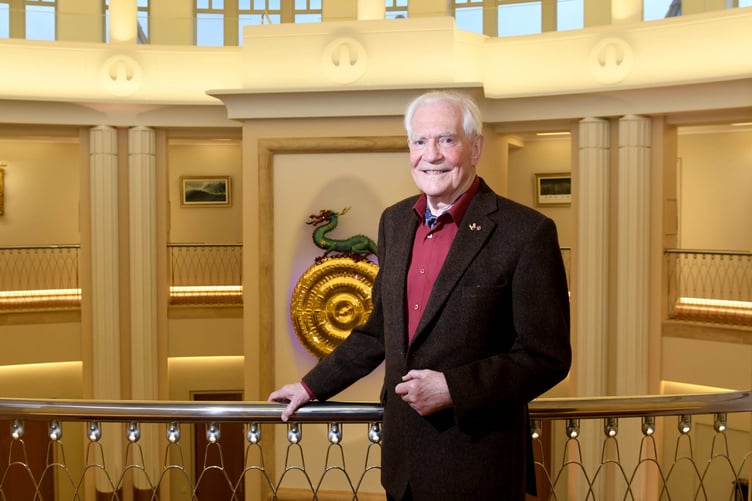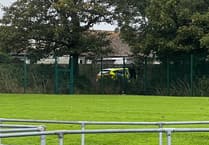I’m looking at a dragon.
But this is not just any dragon. This is a chronophage, a time eater. It’s the relentless pacing of this creature that drives the mechanism in what is one of the most unusual clocks in the world.
The dragon carries a pearl in its mouth and, as every minute passes, he appears to swallow the pearl: as he does so, a delighted shiver runs down his scaly spine and his tail quivers with pleasure. It is fascinating to watch but it also conveys the unsettling reminder that time, once it’s gone, is gone forever.
The Chinese, apparently, viewed dragons rather differently than we do. ‘They believe that a dragon brings good fortune to your home,’ says Dr John C Taylor, the designer of the clock. He is taking me on a tour of his house in Santon where the dragon clock has the place of honour on the wall in the large round entrance hall. Except that it’s not round. Like the house itself it’s actually elliptical.
It just depends what angle you are looking at it from.
Dr Taylor calls his website ‘Welcome to my World’ and his house is a reflection of this idea of things changing depending on how you look at them. As an inventor, he tends to look at things in a different way from most people, in order to find new ways of making them work better.
He’s the one who invented the kettle control switch that means you can walk away and leave the water to come to the boil, knowing that it will turn itself off once it’s done so, and not boil dry. It’s reckoned that more than two billion of these switches have been sold around the world. It was through this invention that Strix, the island’s most successful manufacturing company and winner of four Queen’s Awards, was built.
Dr Taylor retired from the company in 1999 but he hasn’t stopped working. Being an inventor is who he is, not what he does. In all, he has around 400 patents to his name.
‘If you’re an inventor you can’t stop inventing,’ he says.
The fact that he is dyslexic has, he believes had a big part to play in this: ‘It gives you a funny way of looking at things because you don’t hear words as a string of syllables, you hear them as ideas. You think of the idea behind the word all the time. It’s a gift. I think a lot of dyslexic people are inventors and innovators.’
His father, Eric Hardman Taylor, was also an inventor. He developed a waterproof and windproof cotton that was used in all the Everest expeditions. During the Second World War he used it to make an electrically heated suit which incorporated the Mae West lifejacket and was standard issue for the bombers and paratroopers.
Dr Taylor still has a letter sent to his father from an airman who wrote: ‘Returning from a raid we were unfortunately hit and we crashed into the sea I was thrown out of the rear turret, knocked unconscious and I came to, floating the right way up and the right way round and I thought you’d like to know this because it saved my life, thank you very much.’
A British Government commission looking into wartime inventions, which awarded Sir Frank Whittle £100,000 for inventing the jet engine, also awarded Dr Taylor’s father £100,000 for saving lives of aircrew.
He says: ‘That would have been several million in today’s money. But the grateful tax office charged him 19s 6d in the pound, which was 97.5%, and after all the allowances he was left with about £10,000 which he used to set up the thermostat company, Otter Controls.’
The family lived in Buxton but Dr Taylor was educated at King William’s College as a boarder, his introdcution to the Isle of Man.
He then went to Corpus Christi College to study natural sciences and, at the end of his second year, in 1958, in the long vacation, he was chosen to go on the Cambridge Spitzbergen Expedition, exploring the Svalbard archipelago in northern Norway.
He recalls: ‘We were away, in round figures, 100 days and it never went dark. We were going to a completely unexplored area and we had to cross the glaciers, man hauling our sledges. We had to carry outboard motors and petrol and oil to mix for two stroke to run them, and we eventually retrieved a boat which had been left two years previously. I had brought a caulking mallet, caulking chisel and caulking compound so that we could make it waterproof.
‘When I look back, we didn’t have any “health and safety”, and as soon as we left the capital of Spitzbergen we were out of all contact with the outside world.’
Just how dangerous it was was brought home to him when one of his friends, who was collecting fossils, fell from a snowy cliff onto a glacier and died.
Dr Taylor might be an inventor but he is no woolly-minded academic. He has always understood exactly how business should work and how to develop and scale up the manufacturing required to keep his business successful.
When he joined Otter Controls which was manufacturing thermostatic controls, there were a lot of things he wanted to change.
He says: ‘My father had designed things that were screwed together because that’s how he thought. He was making hundreds whereas I wanted to make hundreds of thousands.’
In 1962 he applied for his first patent and invited four friends who were also Cambridge MAs to join him in the company as the older generation of directors retired.
He recalls: ‘With the new products I’d designed, the new production methods and the help of my friends, the company just took off. We used to grow 25 to 35% compound every year – manufacturing industry can’t do that, but we did. And, if you establish a market, you’ve go to fulfil it because if you can’t fulfil it somebody else will come in.
‘The whole thing about patents is that you keep other people out and then it’s almost a licence to print money but you’ve got to expand to fulfil your commitment to the market. We were able to do that with me designing automation so that if the production doubled in the company we only had 10% more people.’
It was family circumstances that brought Dr Taylor to the Isle of Man where Otter had a small factory. In 1977, after his marriage broke up, he brought his two children, seven-year-old Laura and five-year-old Neil to live here to be able to spend more time with them.
Sadly he and his former friends in Otter Controls parted ways after they had issued more shares for themselves, behind his back and in contravention of the company’s Articles. He left and set up Strix in 1981 with the late Eddie Davies as managing director but that wasn’t the last he saw of his former partners. They copied his design for a kettle control that would work in the plastic kettles that were becoming increasingly popular, thus infringing his patent. Dr Taylor took them to court and, after a legal battle lasting seven years, he won and they finally settled.
And Strix has gone from strength to strength.
Dr Taylor says: ‘In 1996 we applied for, and won, the UK Manufacturer of the Year. The next year we applied for a Queen’s Award for Export and got it; two years after that we applied for a Queen’s Award for Export and we got it. Two years after that we applied for a Queen’s Award for export and we got it, and the fourth time it was for the 360 degree cordless kettle, also my invention, and we got that Award for Technical Excellence.
‘So this little Isle of Man company has won four Queen’s Awards and been named UK Manufacturer of the Year. There are very few companies, even in the UK, that have won four Queen’s Awards.’
Since retiring Dr Taylor has had time to concentrate on another of his interests, horology, which led to the invention of the chronophage clock, which tells the time mechanically without using hands to represent minutes and hours.
There are only three of these clocks in the world. The first one, which he gave to his old college, Corpus Christi, Cambridge, features a huge grasshopper. It was unveiled in 2008 by Professor Stephen Hawking and is now the most popular visitor attraction in the city, drawing several million people a year to come and see it.
The other chronophages are on the island, one in Dr Taylor’s home and the other where anyone can go and see it, on the wall outside the 1886 Bar in Douglas. This one is called the Midsummer and has been based on an enormous mythical fly-like creature with intricate wings and a sting in its tail.
In Dr Taylor’s own words, the chronophage delivers a message we should all heed: ‘Use every minute, look forward and use the time that you’ve got to the best advantage.’

.jpeg?width=209&height=140&crop=209:145,smart&quality=75)


.png?width=209&height=140&crop=209:145,smart&quality=75)
Comments
This article has no comments yet. Be the first to leave a comment.